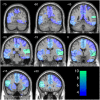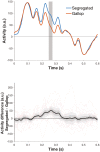Magnetoencephalographic Correlates of Perceptual State During Auditory Bistability
- PMID: 29343771
- PMCID: PMC5772671
- DOI: 10.1038/s41598-018-19287-0
Magnetoencephalographic Correlates of Perceptual State During Auditory Bistability
Abstract
Bistability occurs when two alternative percepts can be derived from the same physical stimulus. To identify the neural correlates of specific subjective experiences we used a bistable auditory stimulus and determined whether the two perceptual states could be distinguished electrophysiologically. Fourteen participants underwent magnetoencephalography while reporting their perceptual experience while listening to a continuous bistable stream of auditory tones. Participants reported bistability with a similar overall proportion of the two alternative percepts (52% vs 48%). At the individual level, sensor space electrophysiological discrimination between the percepts was possible in 9/14 participants with canonical variate analysis (CVA) or linear support vector machine (SVM) analysis over space and time dimensions. Classification was possible in 14/14 subjects with non-linear SVM. Similar effects were noted in an unconstrained source space CVA analysis (classifying 10/14 participants), linear SVM (classifying 9/14 subjects) and non-linear SVM (classifiying 13/14 participants). Source space analysis restricted to a priori ROIs showed discrimination was possible in the right and left auditory cortex with each classification approach but in the right intraparietal sulcus this was only apparent with non-linear SVM and only in a minority of particpants. Magnetoencephalography can be used to objectively classify auditory experiences from individual subjects.
Conflict of interest statement
The authors declare that they have no competing interests.
Figures




References
Publication types
MeSH terms
Grants and funding
LinkOut - more resources
Full Text Sources
Other Literature Sources

